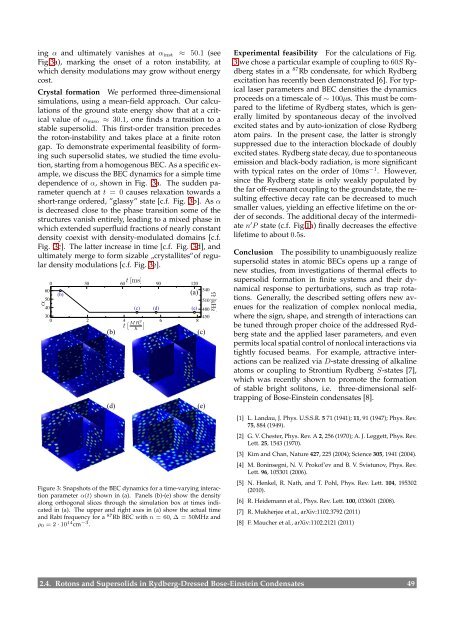Contents - Max-Planck-Institut für Physik komplexer Systeme
Contents - Max-Planck-Institut für Physik komplexer Systeme
Contents - Max-Planck-Institut für Physik komplexer Systeme
You also want an ePaper? Increase the reach of your titles
YUMPU automatically turns print PDFs into web optimized ePapers that Google loves.
ing α and ultimately vanishes at αinst ≈ 50.1 (see<br />
Fig.3a), marking the onset of a roton instability, at<br />
which density modulations may grow without energy<br />
cost.<br />
Crystal formation We performed three-dimensional<br />
simulations, using a mean-field approach. Our calculations<br />
of the ground state energy show that at a critical<br />
value of αsuso ≈ 30.1, one finds a transition to a<br />
stable supersolid. This first-order transition precedes<br />
the roton-instability and takes place at a finite roton<br />
gap. To demonstrate experimental feasibility of forming<br />
such supersolid states, we studied the time evolution,<br />
starting from a homogenous BEC. As a specific example,<br />
we discuss the BEC dynamics for a simple time<br />
dependence of α, shown in Fig. 3a. The sudden parameter<br />
quench at t = 0 causes relaxation towards a<br />
short-range ordered, ”glassy” state [c.f. Fig. 3b]. As α<br />
is decreased close to the phase transition some of the<br />
structures vanish entirely, leading to a mixed phase in<br />
which extended superfluid fractions of nearly constant<br />
density coexist with density-modulated domains [c.f.<br />
Fig. 3c]. The latter increase in time [c.f. Fig. 3d], and<br />
ultimately merge to form sizable ” crystallites“of regular<br />
density modulations [c.f. Fig. 3e].<br />
α<br />
60<br />
50<br />
40<br />
0 30 60 90 120<br />
(b)<br />
30<br />
0 2 4 6 8<br />
t [ MR2 c<br />
]<br />
(b) (c)<br />
(d)<br />
t [ms]<br />
(a)<br />
(c) (d) (e)<br />
Figure 3: Snapshots of the BEC dynamics for a time-varying interaction<br />
parameter α(t) shown in (a). Panels (b)-(e) show the density<br />
along orthogonal slices through the simulation box at times indicated<br />
in (a). The upper and right axes in (a) show the actual time<br />
and Rabi frequency for a 87 Rb BEC with n = 60, ∆ = 50MHz and<br />
ρ0 = 2 · 10 14 cm −3 .<br />
(e)<br />
540<br />
510<br />
480<br />
450<br />
Ω [kHz]<br />
Experimental feasibility For the calculations of Fig.<br />
3 we chose a particular example of coupling to 60S Rydberg<br />
states in a 87 Rb condensate, for which Rydberg<br />
excitation has recently been demonstrated [6]. For typical<br />
laser parameters and BEC densities the dynamics<br />
proceeds on a timescale of ∼ 100µs. This must be compared<br />
to the lifetime of Rydberg states, which is generally<br />
limited by spontaneous decay of the involved<br />
excited states and by auto-ionization of close Rydberg<br />
atom pairs. In the present case, the latter is strongly<br />
suppressed due to the interaction blockade of doubly<br />
excited states. Rydberg state decay, due to spontaneous<br />
emission and black-body radiation, is more significant<br />
with typical rates on the order of 10ms −1 . However,<br />
since the Rydberg state is only weakly populated by<br />
the far off-resonant coupling to the groundstate, the resulting<br />
effective decay rate can be decreased to much<br />
smaller values, yielding an effective lifetime on the order<br />
of seconds. The additional decay of the intermediate<br />
n ′ P state (c.f. Fig.1a) finally decreases the effective<br />
lifetime to about 0.5s.<br />
Conclusion The possibility to unambiguously realize<br />
supersolid states in atomic BECs opens up a range of<br />
new studies, from investigations of thermal effects to<br />
supersolid formation in finite systems and their dynamical<br />
response to perturbations, such as trap rotations.<br />
Generally, the described setting offers new avenues<br />
for the realization of complex nonlocal media,<br />
where the sign, shape, and strength of interactions can<br />
be tuned through proper choice of the addressed Rydberg<br />
state and the applied laser parameters, and even<br />
permits local spatial control of nonlocal interactions via<br />
tightly focused beams. For example, attractive interactions<br />
can be realized via D-state dressing of alkaline<br />
atoms or coupling to Strontium Rydberg S-states [7],<br />
which was recently shown to promote the formation<br />
of stable bright solitons, i.e. three-dimensional selftrapping<br />
of Bose-Einstein condensates [8].<br />
[1] L. Landau, J. Phys. U.S.S.R. 5 71 (1941); 11, 91 (1947); Phys. Rev.<br />
75, 884 (1949).<br />
[2] G. V. Chester, Phys. Rev. A 2, 256 (1970); A. J. Leggett, Phys. Rev.<br />
Lett. 25, 1543 (1970).<br />
[3] Kim and Chan, Nature 427, 225 (2004); Science 305, 1941 (2004).<br />
[4] M. Boninsegni, N. V. Prokof’ev and B. V. Svistunov, Phys. Rev.<br />
Lett. 96, 105301 (2006).<br />
[5] N. Henkel, R. Nath, and T. Pohl, Phys. Rev. Lett. 104, 195302<br />
(2010).<br />
[6] R. Heidemann et al., Phys. Rev. Lett. 100, 033601 (2008).<br />
[7] R. Mukherjee et al., arXiv:1102.3792 (2011)<br />
[8] F. Maucher et al., arXiv:1102.2121 (2011)<br />
2.4. Rotons and Supersolids in Rydberg-Dressed Bose-Einstein Condensates 49
















